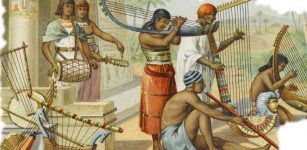Daily Life Of Télpochcalli Students Of The Aztec Empire Was A Challenge
Conny Waters - AncientPages.com - Why the Aztecs migrated to the Mexican Valley can be debated, but once they reached the place it didn’t take long before they became the most powerful Mesoamerican kingdom of all time.
“The Nahuatl word aztecatl means “people from Aztlan”. Aztlan is most likely a mythological region that is regarded to have been the origin not only for the Aztecs but for seven different city states in Mesoamerica, of which the Aztecs are but one example.
Historians have traced possible locations for this city – from islands in the South Pacific to Northwestern Mexico and to the South West of the United States.
Before the Aztecs could become warriors they had to be trained properly. Image source
Most of these take as their basis in apocryphal Aztec sayings, which were recorded by Spanish imperials. Thus, the true location of Aztlan will probably always remain a matter of contention. Interestingly, there is no known meaning of the word Aztlan in Nahuatl. The Aztecs themselves had rejected the word Aztec – preferring to call themselves “Mexica”.
It was the 19th century European archaeologists that began using the word Aztec to differ them from other Mesoamerican cultures.” 1
By the early 16th century, the Aztecs ruled over up to 500 small states, and between 5 to 6 million people. Their empire was huge and prosperous.
The Aztec Empire was undoubtedly strong and powerful, but the success of their famous warriors demanded extremely hard training and discipline.
The Aztec Eagle Warriors and Jaguar Warriors struck fear in their enemy, but before they were allowed to fight, they had to be properly trained.
The Aztecs had a school called Télpochcalli where all sons of lower-class citizens received military train that was mandatory.
Boys went to this school when they were 15 years old and their teachers were skilled Aztec warriors who were slightly older. Attending the Télpochcalli was demanding and not everyone managed to become a future Aztec warrior. The purpose of Télpochcalli was to teach students discipline, bravery, and respect and this was accomplished through hard labor and brutal punishments.
The Aztec Empire wanted to have courageous warriors who could achieve success whenever it was necessary. Not all boys succeeded in the harsh training. Those who were tough and passed the training had the honor to serve the mighty Aztec Empire. Having an elevated status in society gave new opportunities in life. Some could even become teachers one day.
What Was It Like To Be A Télpochcalli Student?
An ordinary day in the life of a Télpochcalli student focused on hard work. Aztec students got up early in the morning. After taking a cold bath and having a very modest meal, they had to clean, farm, repair aqueducts, canals, and other buildings. This was part of their physical training with the purpose of strengthening their sense of civic duty. By working together, they learned to cooperate and experience unity and interconnectedness, which were basic requirements for every future warrior.
Young boys learned martial arts and were instructed how to handle Aztec weapons. Many of these weapons were designed to not only kill but to incapacitate, stun or immobilize the enemy. Sometimes it happened that one of the Télpochcalli teachers was required to participate in a war. If this was the case, the Télpochcalli student followed his teacher and served as his apprentices in battle. This meant the youngster started by carrying weapons and late, if he was ready for it, he could help capture enemy prisoners.
See also:
Aztec Empire: ‘Tlatoani’ – The Ruler With The Ultimate Power In The Land
Slaves In The Aztec Empire Had Much Better Rights Than In Any Other Ancient Society
One can imagine many young boys wanted to participate in a battle as soon as possible, but this was not allowed. To prepare, youngsters had to first test their skills in mock fights. How mock fights were organized varied. Sometimes when religious festivals were organized a future warrior could test his skills and strength fighting an enemy prisoner who had been captured in was. It was also not uncommon to stage battles between Télpochcalli students. The one who won the battle received a prize such as food or gifts.
Aztec warriors as depicted in the Codex Mendoza.
“By the time a boy left school he was a warrior, but he still couldn’t go to war alone. First, he had to find a sponsor, a veteran who could accompany him into his first battle. Parents would use food, drink, and gifts to bribe these veterans to watch over their sons, and so it was usually the richer boys who had greater success in war.
The rules of the Télpochcallis were strict and anyone who broke them or deviated from their training was severely punished. For example. A student caught with alcohol could be beaten or even hanged, and leaving school to live with a prostitute warranted being burnt with a stick. Even the teachers could be punished, with their valuables taken and hair cut if they misbehaved.” 2
Being a Télpochcalli student was a challenge and not everyone could complete these studies, but that how the Aztecs trained their warriors to become successful on the battlefield.
Written by Conny Waters – AncientPages.com Staff Writer
Copyright © AncientPages.com All rights reserved. This material may not be published, broadcast, rewritten or redistributed in whole or part without the express written permission of AncientPages.com
Expand for references- Prince, William Myron. Aztec History: The Incredible History Of One Of The Greatest Ancient Civilizations Of Our World
- All About History Aztecs First Edition, Future Publishing Limited, 2019
More From Ancient Pages
-
 Black Granite Statue Of King Amenhotep III Accidentally Recovered
Archaeology | Jan 1, 2016
Black Granite Statue Of King Amenhotep III Accidentally Recovered
Archaeology | Jan 1, 2016 -
 1,500-Year-Old Fingerprints Will Say Much About Potters And Communities That Once Lived In Motza
Archaeology | Nov 10, 2022
1,500-Year-Old Fingerprints Will Say Much About Potters And Communities That Once Lived In Motza
Archaeology | Nov 10, 2022 -
 Naglfar Nail-Ship Carries Demonic Forces To Ragnarok In Norse Beliefs
Featured Stories | Aug 10, 2020
Naglfar Nail-Ship Carries Demonic Forces To Ragnarok In Norse Beliefs
Featured Stories | Aug 10, 2020 -
 What Is The Giant Neolithic Circular Structure Near Durrington Walls Henge?
Archaeology | Dec 3, 2025
What Is The Giant Neolithic Circular Structure Near Durrington Walls Henge?
Archaeology | Dec 3, 2025 -
 How Important Was Music In Ancient Egypt?
Ancient History Facts | Jan 16, 2021
How Important Was Music In Ancient Egypt?
Ancient History Facts | Jan 16, 2021 -
 Mead: Secret Drink Of The Vikings And Gods – Was It An Ancient Antibiotic?
News | Feb 21, 2016
Mead: Secret Drink Of The Vikings And Gods – Was It An Ancient Antibiotic?
News | Feb 21, 2016 -
 Remains Of Colonnaded Hall Of 26th Dynasty Found At Ancient Buto Temple, Northern Nile Delta
Archaeology | Nov 18, 2022
Remains Of Colonnaded Hall Of 26th Dynasty Found At Ancient Buto Temple, Northern Nile Delta
Archaeology | Nov 18, 2022 -
 Islands Of The Tropical Pacific Ocean Were Settled Much Earlier Than Previously Thought – New Theory
Archaeology | Dec 20, 2022
Islands Of The Tropical Pacific Ocean Were Settled Much Earlier Than Previously Thought – New Theory
Archaeology | Dec 20, 2022 -
 On This Day In History: Canute Lavard Was Murdered By His Cousin, Magnus I Of Sweden – On Jan 7, 1131
Historical Figures | Jan 7, 2017
On This Day In History: Canute Lavard Was Murdered By His Cousin, Magnus I Of Sweden – On Jan 7, 1131
Historical Figures | Jan 7, 2017 -
 Does A Baffling Artifact Offer Evidence Of Ancient Extraterrestrial Visitation In New Zealand? – The Discovery – Part 1
Ancient Mysteries | Jul 20, 2020
Does A Baffling Artifact Offer Evidence Of Ancient Extraterrestrial Visitation In New Zealand? – The Discovery – Part 1
Ancient Mysteries | Jul 20, 2020 -
 Unusual Neolithic Burial From Grotta Di Pietra Sant’ Angelo Puzzles Archaeologists
Featured Stories | Jan 15, 2024
Unusual Neolithic Burial From Grotta Di Pietra Sant’ Angelo Puzzles Archaeologists
Featured Stories | Jan 15, 2024 -
 Tomb of Patriarchs In Hebron Was Used And Visited By Pilgrims 2,700 Years Ago – New Study
Archaeology | Jul 10, 2020
Tomb of Patriarchs In Hebron Was Used And Visited By Pilgrims 2,700 Years Ago – New Study
Archaeology | Jul 10, 2020 -
 Were Mysterious Ancient Man-Made Earthworks In The Amazon Forest Ritual Communication Spaces?
Archaeology | Sep 6, 2017
Were Mysterious Ancient Man-Made Earthworks In The Amazon Forest Ritual Communication Spaces?
Archaeology | Sep 6, 2017 -
 900-Year-Old Crypt At Old Dongola: Magical Inscriptions And Mysterious Signs Found
Archaeology | Sep 12, 2015
900-Year-Old Crypt At Old Dongola: Magical Inscriptions And Mysterious Signs Found
Archaeology | Sep 12, 2015 -
 Clothing And Jewelry In Ancient Egypt – How Did The Ancient Egyptians Dress?
Ancient History Facts | Jun 7, 2020
Clothing And Jewelry In Ancient Egypt – How Did The Ancient Egyptians Dress?
Ancient History Facts | Jun 7, 2020 -
 Evidence The Khufu Channel Aided The Construction Of The Giza Pyramids Found – Scientists Say
Archaeology | Aug 31, 2022
Evidence The Khufu Channel Aided The Construction Of The Giza Pyramids Found – Scientists Say
Archaeology | Aug 31, 2022 -
 Fluctuating Oxygen Levels May Have Accelerated Animal Evolution
Archaeology | Oct 19, 2022
Fluctuating Oxygen Levels May Have Accelerated Animal Evolution
Archaeology | Oct 19, 2022 -
 Final Journey Of Ötzi Iceman: More Clues Found In Frozen Moss
Archaeology | Nov 1, 2019
Final Journey Of Ötzi Iceman: More Clues Found In Frozen Moss
Archaeology | Nov 1, 2019 -
 Michelangelo’s Hidden Secrets Under The Medici Chapel
Featured Stories | Jul 16, 2019
Michelangelo’s Hidden Secrets Under The Medici Chapel
Featured Stories | Jul 16, 2019 -
 Unknown Holographic Technology Hidden In Old Monastery Reveals A Surprising Secret
Ancient Mysteries | Dec 7, 2018
Unknown Holographic Technology Hidden In Old Monastery Reveals A Surprising Secret
Ancient Mysteries | Dec 7, 2018


